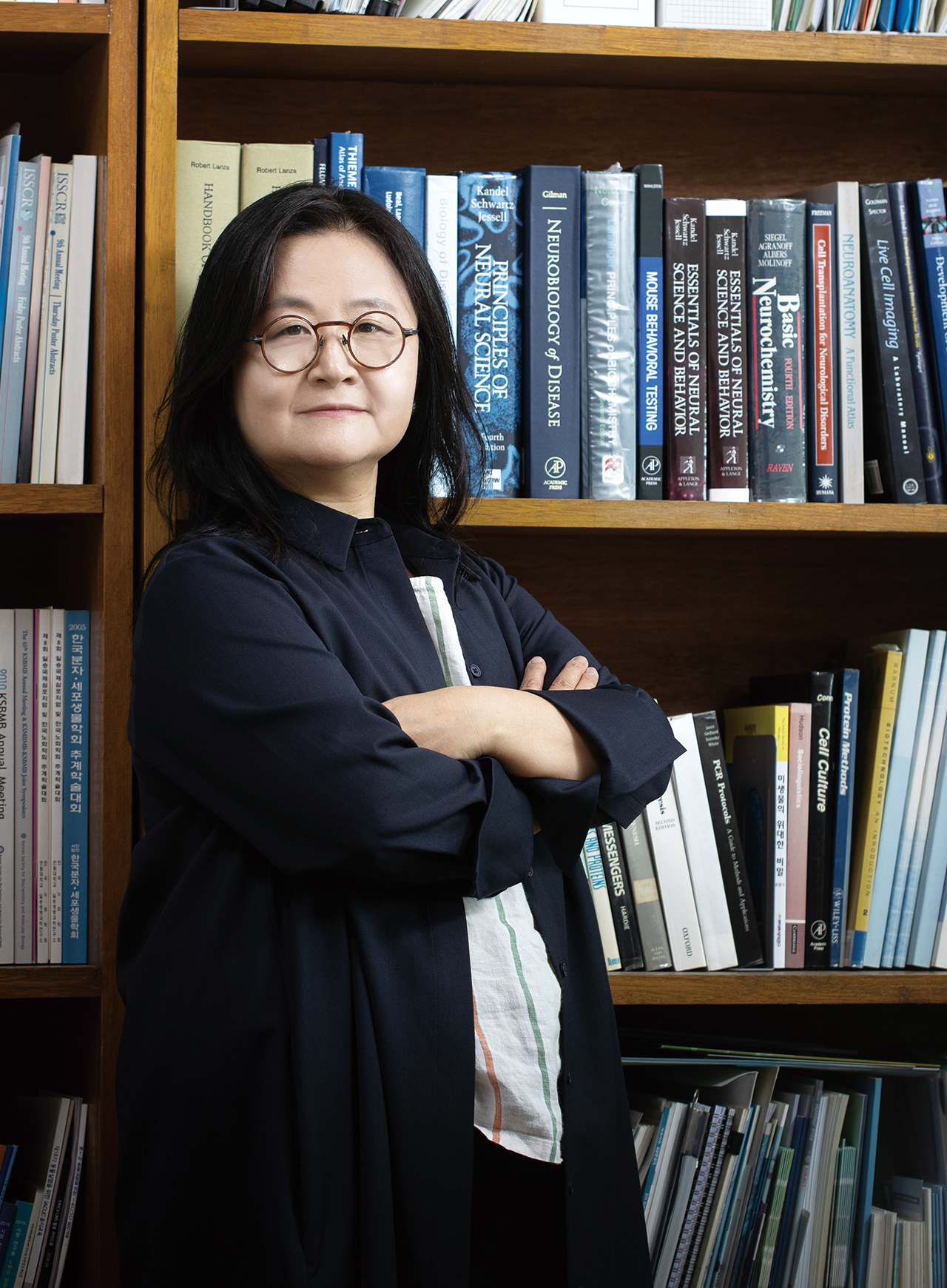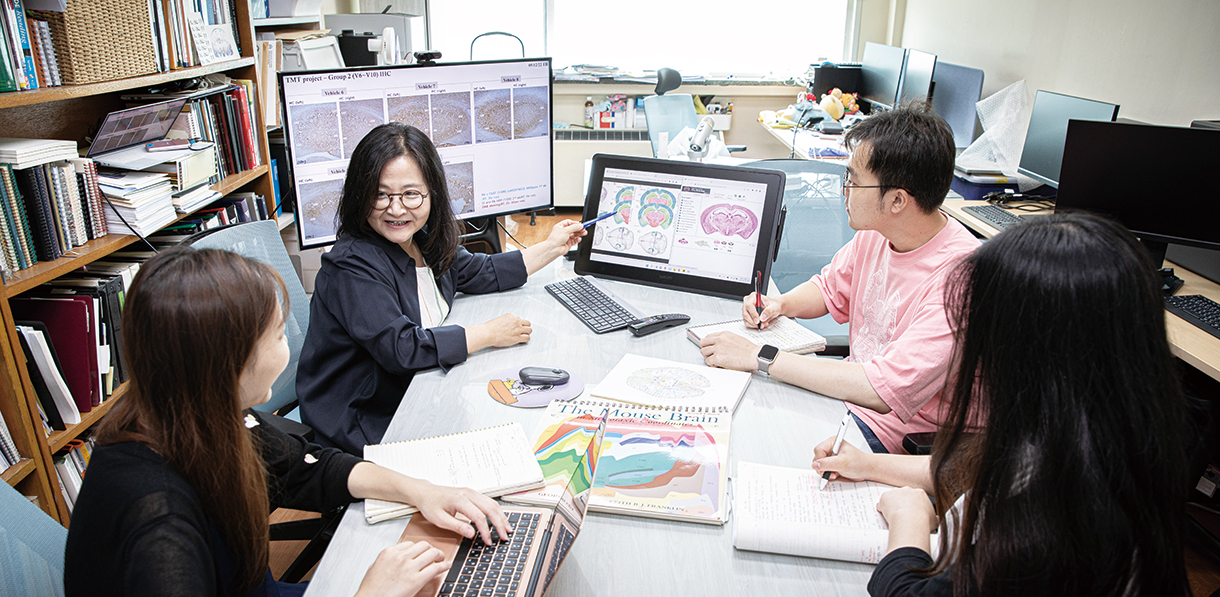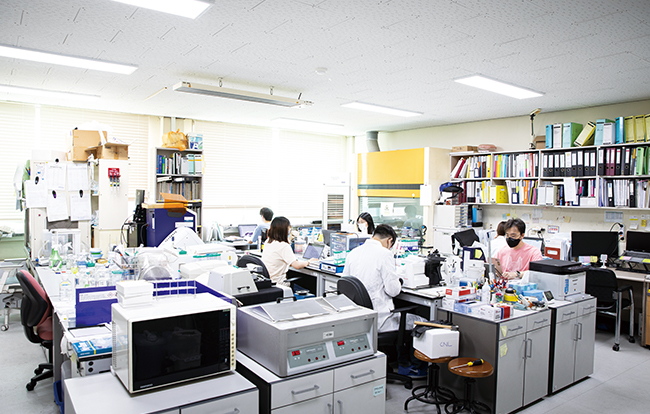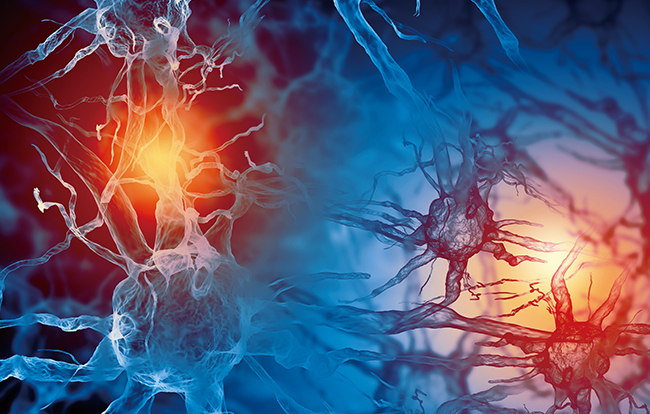

Story
손상된 뇌세포
복구의 스위치를 찾아라
Find the Switches to Recover Damaged Brain Cells
ERICA캠퍼스 분자생명과학과 서혜명 교수
Professor Hyemyung Seo, Department of Molecular & Life Science, ERICA Campus
- 글 박영임
- 사진 손초원
- Writing Park Yeong-im
- Photograph Son Cho-won
Scroll Down
Increased human life expectancy is not something we can only find joy in. That is because degenerative brain and neurological disorders that debase human dignity, such as Alzheimer’s disease (AD) and Parkinson's disease (PD), are also increasing. Professor Hyemyung Seo, who studies the pathological mechanisms of neurodegenerative diseases, believes that brain science research can become a scientific stepping stone for a healthier future in the aging society.

헌팅턴병의 병리 기전을 밝히다
미국의 의사 헌팅턴(Huntington)에게 처음 발견된 헌팅턴병은 한때 무도병이라 불렸다. 이 병에 걸린 사람들의 멋대로 움직이는 몸이 마치 춤을 추는 것처럼 보였기 때문이다. 하지만 이는 추고 싶어 추는 춤이 아니다. 의지와 상관없이 쉬지 않고 움직이는 팔, 다리와 얼굴 근육의 비자발성 움직임이 헌팅턴병의 증상이다. 그러나 탈진할 때까지 춤을 추는 것이 병인 줄 몰랐던 시기에는 환자가 마녀에 씌였다며 종교재판을 열기도 했다. 모두 뇌과학이 발달하기 전 무지로 인해 벌어진 참극이다. 지난해 서혜명 교수는 헌팅턴병의 뇌 신경세포 손상 기전을 발견해 주목받았다.
“KIST 뇌과학연구소, 보스턴대 연구팀과 함께 헌팅턴병 환자의 뇌조직, 마우스, 세포모델을 실험했습니다. 이를 통해 신경세포 사멸을 억제하는 XIAP 단백질이 정상적으로 발현되지 않게 되면서 미토콘드리아의 기능에 문제가 생기는 현상을 발견했어요. 마우스 모델이 아니라 헌팅턴 환자의 뇌조직에서 발견한 새로운 병리기전이라는 점이 본 연구의 큰 의의입니다. 헌팅턴병뿐 아니라 파킨슨병, 알츠하이머 같은 다른 퇴행성 뇌 신경계 질환의 병리 기전을 이해하는 데도 도움이 될 것입니다. 질환의 병리 기전을 밝혀야 그 기전을 돌이킬 수 있는 스위치를 찾고, 질병 극복 메커니즘을 발동시킬 수 있죠.”
우리의 뇌는 수십억 개의 신경세포로 이루어져 있는데 서로 복잡하게 얽혀 있어 정보를 교환하며 감각과 움직임, 언어, 기억, 사고 등 신체 각 부분을 통솔한다. 열심히 임무를 수행하던 중 특정 신경세포가 사멸하거나 연결에 문제가 발생하면 해당 세포가 관장하고 있던 신체 기능에 이상이 생긴다. 서혜명 교수는 왜 특정 뇌 신경세포가 특정 퇴행성 질환으로 특이적으로 퇴행하는지 그 병리학적 기전을 연구하고 있다.
예를 들어 대표적인 퇴행성 뇌 신경계 질환으로 꼽히는 헌팅턴병, 파킨슨병, 알츠하이머의 공통점은 모두 노화에 의해 점진적인 퇴행 과정을 겪는다는 점이다. 하지만 알츠하이머는 인지능력이 퇴행해 기억이 감소하고, 헌팅턴병과 파킨슨병은 움직임이라는 동일한 지점에 문제가 발생하는 것이다. 헌팅턴병은 원치 않는 움직임이 일어나는 것이며 파킨슨병은 원하는 대로 움직이지 못하는 것이다. 이렇게 특정 기능만 퇴행하는 것을 ‘선택적 취약성(Selective Vulnerability)’이라 한다.
“세포 내 모든 대사를 위한 에너지원을 만들어내고 사용하는 과정이 필요한데, 세포가 퇴행하는 단계에서는 이러한 과정에 문제가 생겨서 특정 세포들이 퇴행하고 죽어가는 현상이 관찰되고 있습니다. 이러한 세포 내 에너지 대사를 연구하는 분야를 바이오에너제틱스(bioenergetics)라 하는데 최근 퇴행성 뇌질환 연구에서 주목받고 있는 분야입니다.”
Revealing the pathological mechanism of Huntington’s disease
Huntington’s disease, first discovered by an American doctor Huntington, was once called chorea. It was because the movements of patients with this disease seemed to be dancing as if in choreography. However, it is not that they want to dance. Huntington’s disease is characterized by involuntary movements of the arms, legs, and facial muscles that move restlessly. However, in earlier centuries when people did not know that dancing until one is exhausted was a disease, they often held inquisitions, claiming that the patient was possessed by a witch. These are tragic events that occurred because of people’s ignorance before the development of brain science. Last year, Professor Hyemyung Seo discovered the mechanism of neuronal damage, receiving wide attention.
“We performed the experiments using the brain tissue from Huntington's disease (HD) patients, and various HD models with the KIST Brain Science Institute and the Boston University Research Team. Through these efforts, we discovered a phenomenon in which mitochondrial functions have problems when XIAP proteins, which control neuron-cell extinction, are not normally generated. This study will help us to understand the pathological mechanism of the other neurodegenerative diseases such as AD and PD in addition to HD. Only by identifying the pathological mechanism of the disease, will we be able to find the switch to reverse that mechanism and overcome the diseases.”
Our brain consists of billions of nerve cells, which are intricately entwined with each other to exchange information and to control each part of the body, such as the senses, movements, language, memory, and accidents. When a specific nerve cell dies out or a connection problem occurs while it is performing its duties, an abnormality occurs in the body function where the cell was in charge. Professor Hyemyung Seo studies the pathological mechanism of why a specific brain nerve cell degenerates specifically to a specific degenerative disease.
For instance, Huntington’s, Parkinson’s, and Alzheimer’s diseases, which are considered to be the representative neurodegenerative diseases, all have in common the fact that sufferers of these diseases undergo a gradual degenerative process with aging. With Alzheimer’s, cognitive abilities decline and lead to memory loss, while with Huntington’s and Parkinson’s, problems occur in movements. With Huntington’s disease, unwanted movements occur in the body; while with Parkinson’s, the body does not move as the patient wants. This degeneration in only certain functions is called “selective vulnerability.”
“Altered cellular metabolism, the process to generate and consume the energy source, is very critical in the progressive degeneration of the specific neurons in the brain. "Bioenergetics" is the research field to study cellular energy metabolism.”

죽어가는 뇌세포를 건강한 세포로 대체
세포가 퇴행하고 죽어가는 것이 문제라면 세포를 치료하거나 건강한 세포로 대체하면 어떨까. 이러한 문제의식에서 출발한 것이 세포치료 연구다. 서혜명 교수는 세포의 퇴행을 늦추고 신경 보호를 유도하기 위해 유전자 치료 및 세포치료 연구를 병행하고 있다. 예를 들면 퇴행성 신경질환에서 문제가 되는 세포를 건강한 세포로 대체하고자, 사람 유도만능줄기세포(hiPSC, human induced pluripotent stem cell) 유래의 건강한 신경세포를 분화하고 기능을 찾아가는 연구를 진행한다.
“퇴행성 뇌 신경질환은 특정 세포들이 그 기능을 감당하지 못해 생기는 질환이므로, 문제 되는 세포를 건강한 세포로 이식해줌으로써 그 질환의 문제점을 극복해보겠다는 접근입니다. 2020년 미국 하버드대학과 공동연구를 통해 파킨슨병 환자의 자가세포치료 임상을 세계 최초로 성공시켜 화제가 된 바 있습니다.”
서혜명 교수는 이렇게 퇴행성 뇌 신경질환을 연구하며 특정 세포를 이해할 수 있게 되면, 이를 통해 뇌라는 인간의 가장 복합한 조직에 한걸음 더 다가갈 수 있다고 말한다. 뇌를 연구한다는 것은 어쩌면 인간 자체를 연구하는 일일지도 모른다.
“우리가 어떻게 생각할 수 있는지, 판단할 수 있는지, 기억할 수 있는지, 어떻게 하면 더 똑똑해질 수 있는지와 같은 인지적인 기능뿐 아니라 어떻게 슬픈지, 기쁜지, 사랑은 무엇이고 미움은 무엇인지, 어떻게 감정의 조절이 가능하며, 정신적인 힘을 키울 수 있는지 등 감정과 정서적인 기능이 작동하는 원리를 알 수 있게 될 것입니다.”
뇌 신경질환의 병리학적 기전을 연구하는 것은 최근 관심이 높아지고 있는 ADHD, 우울증, 강박장애, 공황장애, 조현병과 같은 정신질환을 치료하는 데도 도움을 줄 수 있다. 이를테면 인지적 문제를 겪는 알츠 하이머의 병리 기전을 통해 환각이나 망상 등을 겪는 조현병 등의 정신질환을 치료할 수 있는 팁을 얻는 것이다.
Replacing dying cells with healthy ones
If the problem is that the cells degenerate and die out, then why do we not treat the dying cells or replace them with healthy ones? Cell therapy started from this thought. Professor Hyemyung Seo is conducting gene therapy and cell therapy to slow neurodegeneration and to induce neuroprotection. For example, in order to replace damaged cells in neurodegenerative diseases with healthy cells, she conducts research to differentiate healthy neurons derived from human induced pluripotent stem cells, or hiPSC, and identify their functions.
“Neurodegenerative diseases occur because certain cells cannot handle their functions. By transplanting healthy cells in place of damaged cells, we are attempting to overcome the problems of the disease. In 2020, joint research with Harvard University in the USA succeeded in the clinical trials of the autologous cell therapy for the first time in the world and became a sensation.”
Professor Hyemyung Seo believes that we would be able to take one step closer to the most complex human organ called the brain by studying the neurodegenerative diseases and understand cellular functions of the specific neurons. Studying the brain may be tantamount to studying the human being as such.
“We would be able to understand the principle of cognitive functions such as how we can think, judge, remember, and become smarter - as well as emotional functions such as why we are sad or happy, what is love, what is hate, how we can control emotions, and develop mental strengths, etc.”
Studying the pathological mechanism of neurological disorders can also help treat mental disorders that are receiving increasing attention these days - such as ADHD, depression, obsessive-compulsive disorder, panic disorder, and schizophrenia. For example, through the pathological mechanism of Alzheimer’s, which causes cognitive problems, we may obtain tips to treat mental disorders such as schizophrenia, which causes hallucinations and delusions.



현대와 같은 고령화 사회에서
뇌과학 연구는 매우 중요하다.
생명과학의 대다수 질문은
뇌과학과 밀접하게 연결돼 있다
Brain science research is very important in the era of the aging society in which we now live. Moreover, most of the life science questions we face are closely related to brain science.
생명과학의 모든 질문은 뇌과학으로 귀결
노인 인구의 급속한 증가로 퇴행성 뇌질환 환자도 증가하고 있다. 이는 비단 환자 개인이나 가족만의 문제가 아니라 국가적, 사회적 문제이다. 그래서 정부 차원에서 뇌질환 연구를 지원하는 국가들이 늘어 전 세계적으로 많은 연구가 이뤄지고 있다. 하지만 실제 인간의 뇌세포를 대상으로 연구하기 어렵다는 것이 뇌과학의 가장 큰 걸림돌이다.
이에 미국을 비롯한 영국, 네덜란드, 호주, 일본, 중국 등은 오래전부터 뇌은행(Brain Bank)을 운영해 왔다. 뇌은행은 죽은 후 뇌질환 연구를 위해 쓰이도록 환자들이 뇌를 기증하는 곳이다. 앞서 언급한 서혜명 교수팀의 헌팅턴병 관련 이전 연구성과들도 실제 헌팅턴병 환자들의 뇌세포를 토대로 연구했기에 가능했다. 세계 최대 뇌은행인 하버드 뇌은행에서 분양받아 연구를 수행했다. 우리나라에서도 뇌은행이 신설되고 있지만, 뇌 기증에 대한 인식은 아직 부족한 실정이다.
“뇌과학 연구는 매우 중요합니다. 생명과학의 대다수 질문은 뇌과학과 밀접하게 연결돼 있습니다. 즉, 미래에 우리가 가지게 될 많은 의과학적인 질문들은 반드시 뇌과학적인 이해를 필요로 합니다. 그리고 하루하루 우리들의 삶 자체가 모두 뇌의 기능으로 인해 이뤄지는 것입니다. 이 모든 과정을 하나씩 이해할 수 있게 되는 것 자체가 매우 흥미로운 일이죠.”
뇌에 대해서라면 몇 시간이고 쉬지 않고 말할 수 있는 서혜명 교수에게 뇌는 언제나 경이로운 연구대상이다. 그래서 뇌에 관한 연구를 멈출 수가 없다.
All questions in life science lead to brain science
With the rapid increase of the elderly population, the number of patients with degenerative brain diseases is also growing. This is not only a problem for individuals and families, but for a nation and society. Therefore, many countries are supporting research into brain diseases, and many researches are being conducted around the world.
However, the biggest obstacle facing brain science is that it is difficult to study actual human brain cells. Countries such as the United States, the Netherlands, Australia, Japan, and China have been operating brain banks for a long time. The brain bank is where patients donate their brains to be used for brain disease research after death. Professor Hyemyung Seo’s team’s performance in the previous research on Huntington’s disease was possible because they could study it based on the brain cells of actual Huntington’s disease patients. The research was conducted by receiving brains from the Harvard Brain Bank, the world’s largest brain bank. Although a brain bank is being established in Korea, most people are still not very aware of brain donation.
“Brain science research is very important. Most of the life science questions are closely related to brain science. In other words, many of the medical questions that we will be facing in the future will require an understanding of brain science. Our everyday life is composed of functions of the brain. It is very exciting to be able to understand all the processes individually.”
For Professor Hyemyung Seo who can talk endlessly for hours about brain, the brain is always a wonderful subject of research. That is why she cannot stop research on the brain.
